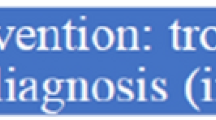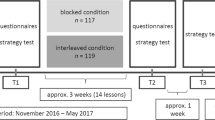Abstract
Research indicates that learning from erroneous examples (EE) is superior to correct examples because errors may provide students with a stimulus to spontaneously produce more self-explanations, leading to better learning outcomes. However, because most studies were conducted in individual settings, it remains an open question whether the advantage of EE could be reproduced in collaborative settings. Therefore, this study used a 2 × 2 factorial design varying in example types (correct vs. erroneous examples) and learning settings (individuals vs. collaboration). An experimental study of a 2-week course on subtraction for third grade students was conducted (N = 109). Results indicated that collaborative learning may enhance the transfer knowledge of subtraction. The improvements were still maintained over 2 weeks. In addition, collaboration also facilitated students’ confidence in handling errors. However, there was no significant difference in promoting isomorphic and transfer knowledge between learning from correct and erroneous examples. Additionally, this study also explored the absence of the intended benefit of erroneous examples from a cognitive load perspective.


Similar content being viewed by others
References
Adams, D. M., McLaren, B. M., Durkin, K., Mayer, R. E., Rittle-Johnson, B., Isotani, S., et al. (2014). Using erroneous examples to improve mathematics learning with a web-based tutoring system. Computers in Human Behavior, 36, 401–411.
Beishuizen, M. (1993). Mental strategies and materials or models for addition and subtraction up to 100 in Dutch second grades. Journal for Research in Mathematics Education, 24(4), 294–323.
Booth, J. L., Lange, K. E., Koedinger, K. R., & Newton, K. J. (2013). Using example problems to improve student learning in algebra: Differentiating between correct and incorrect examples. Learning and Instruction, 25, 24–34.
Bridger, E., & Mecklinger, A. (2014). Errorful and errorless learning: The impact of cue–target constraint in learning from errors. Memory & Cognition, 42(6), 898–911.
Brown, J. S., & VanLehn, K. (1980). Repair Theory: A generative theory of bugs in procedural skills. Cognitive Science, 4(4), 379–426.
Catrambone, R., & Holyoak, K. J. (1989). Overcoming contextual limitations on problem-solving transfer. Journal of Experimental Psychology. Learning, Memory, and Cognition, 15(6), 1147.
Chen, M.-P., Wong, Y.-T., & Wang, L.-C. (2014). Effects of type of exploratory strategy and prior knowledge on middle school students’ learning of chemical formulas from a 3D role-playing game. Educational Technology Research and Development, 62(2), 163–185.
Chi, M. T. H., Bassok, M., Lewis, M. W., Reimann, P., & Glaser, R. (1989). Self-explanations: How students study and use examples in learning to solve problems. Cognitive Science, 13(2), 145–182.
Curry, L. A. (2004). The effects of self-explanations of correct and incorrect solutions on algebra problem-solving performance. Paper presented at the 26th Annual Conference of the Cognitive Science Society, Chicago.
Durkin, K., & Rittle-Johnson, B. (2012). The effectiveness of using incorrect examples to support learning about decimal magnitude. Learning and Instruction, 22(3), 206–214.
Dweck, C. S. (1996). Implicit theories as organizers of goals and behavior. In P. Gollwitzer, & J. A. Bargh (Eds.), The Psychology of Action: Linking Cognition and Motivation to Behavior (pp. 69–90): Guilford.
Fiori, C., & Zuccheri, L. (2005). An experimental research on error patterns in written subtraction. Educational Studies in Mathematics, 60(3), 323–331.
Große, C. S., & Renkl, A. (2007). Finding and fixing errors in worked examples: Can this foster learning outcomes? Learning and Instruction, 17(6), 612–634.
Heemsoth, T., & Heinze, A. (2014). The impact of incorrect examples on learning fractions: A field experiment with 6th grade students. Instructional Science, 42(4), 639–657.
Heitzmann, N. (2014). Fostering diagnostic competence in different domains. Dissertation, LMU Munich,
Isotani, S., Adams, D., Mayer, R. E., Durkin, K., Rittle-Johnson, B., & McLaren, B. M. (2011). Can erroneous examples help middle-school students learn decimals? Paper presented at the 6th European Conference On Technology Enhanced Learning, Palermo.
Kerr, N. L., & Bruun, S. E. (1981). Ringelmann revisited: Alternative explanations for the social loafing effect. Personality and Social Psychology Bulletin, 7(2), 224–231.
Kirschner, F., Paas, F., & Kirschner, P. A. (2009). A cognitive load approach to collaborative learning: United brains for complex tasks. Educational Psychology Review, 21(1), 31–42.
Klopp, E., Stark, R., Kopp, V., & Fischer, M. R. (2013). Psychological factors affecting medical students’ learning with erroneous worked examples. Journal of Education and Learning, 2(1), 158–170.
Kollar, I., Ufer, S., Reichersdorfer, E., Vogel, F., Fischer, F., & Reiss, K. (2014). Effects of collaboration scripts and heuristic worked examples on the acquisition of mathematical argumentation skills of teacher students with different levels of prior achievement. Learning and Instruction, 32, 22–36.
Leppink, J., Paas, F., van Gog, T., van der Vleuten, C. P. M., & van Merriënboer, J. J. G. (2014). Effects of pairs of problems and examples on task performance and different types of cognitive load. Learning and Instruction, 30, 32–42.
Litzler, E., Samuelson, C., & Lorah, J. (2014). Breaking it down: Engineering student STEM confidence at the intersection of race/ethnicity and gender. Research in Higher Education, 55(8), 810–832.
McEldoon, K. L., Durkin, K. L., & Rittle-Johnson, B. (2013). Is self-explanation worth the time? A comparison to additional practice. British Journal of Educational Psychology, 83(4), 615–632.
McLaren, B., Adams, D., Durkin, K., Goguadze, G., Mayer, R., Rittle-Johnson, B., et al. (2012). To err is human, to explain and correct is divine: A study of interactive erroneous examples with middle school math students. Paper presented at the 7th European Conference on Technology Enhanced Learning, Saarbrücken.
Melis, E., Sander, A., & Tsovaltzi, D. (2010). How to support meta-cognitive skills for finding and correcting errors? Paper presented at the AAAI Fall Symposium: Cognitive and Metacognitive Educational Systems, Arlington
Moreno, R., Reisslein, M., & Ozogul, G. (2009). Optimizing worked-example instruction in electrical engineering: The role of fading and feedback during problem-solving practice. Journal of Engineering Education, 98(1), 83–92.
O’Donnell, A. M. (2006). The role of peers and group learning. In P. A. Alexander & P. H. Winne (Eds.), Handbook of Educational Psychology (pp. 781–802). Mahwah: Lawrence Erlbaum Associates Publishers.
Peltenburg, M., van den Heuvel-Panhuizen, M., & Doig, B. (2009). Mathematical power of special-needs pupils: An ICT-based dynamic assessment format to reveal weak pupils’ learning potential. British Journal of Educational Technology, 40(2), 273–284.
Quilici, J. L., & Mayer, R. (1996). Role of examples in how students learn to categorize statistics word problems. Journal of Educational Psychology, 88(1), 144–161.
Renkl, A. (1999). Learning mathematics from worked-out examples: Analyzing and fostering self-explanations. European Journal of Psychology of Education, 14(4), 477–488.
Renkl, A. (2002). Worked-out examples: Instructional explanations support learning by self-explanations. Learning and Instruction, 12(5), 529–556.
Renkl, A. (2014). Toward an instructionally oriented theory of example-based learning. Cognitive Science, 38(1), 1–37.
Retnowati, E., Ayres, P., & Sweller, J. (2010). Worked example effects in individual and group work settings. Educational Psychology, 30(3), 349–367.
Rybowiak, V., Garst, H., Frese, M., & Batinic, B. (1999). Error orientation questionnaire (EOQ): Reliability, validity, and different language equivalence. Journal of Organizational Behavior, 20(4), 527–547.
Safadi, R., & Yerushalmi, E. (2014). Problem solving vs. troubleshooting tasks: The case of sixth-grade students studying simple electric circuits. International Journal of Science and Mathematics Education, 12(6), 1341–1366.
Siegler, R. S., & Chen, Z. (2008). Differentiation and integration: Guiding principles for analyzing cognitive change. Developmental Science, 11(4), 433–448.
Stark, R., Kopp, V., & Fischer, M. R. (2011). Case-based learning with worked examples in complex domains: Two experimental studies in undergraduate medical education. Learning and Instruction, 21(1), 22–33.
Sweller, J. (2010). Element interactivity and intrinsic, extraneous, and germane cognitive load. Educational Psychology Review, 22(2), 123–138.
Sweller, J., & Cooper, G. A. (1985). The use of worked examples as a substitute for problem solving in learning algebra. Cognition and Instruction, 2(1), 59–89.
Sweller, J., van Merrienboer, J. G., & Paas, F. W. C. (1998). Cognitive architecture and instructional design. Educational Psychology Review, 10(3), 251–296.
Tsovaltzi, D., Melis, E., McLaren, B. M., Dietrich, M., Goguadze, G., & Meyer, A.-K. (2009). Erroneous examples: A preliminary investigation into learning benefits. Paper presented at the 4th European Conference On Technology Enhanced Learning, Nice.
Webb, N. M. (1991). Task-related verbal interaction and mathematics learning in small groups. Journal for Research in Mathematics Education, 22(5), 366–389.
Acknowledgments
This study was supported by the National Social Science Fund of China (14BGL131) and the National Key Technology R&D Program of China (Grant No. 2013BAH72B01).
Author information
Authors and Affiliations
Corresponding author
Rights and permissions
About this article
Cite this article
Yang, Zk., Wang, M., Cheng, H.N.H. et al. The Effects of Learning from Correct and Erroneous Examples in Individual and Collaborative Settings. Asia-Pacific Edu Res 25, 219–227 (2016). https://doi.org/10.1007/s40299-015-0253-2
Published:
Issue Date:
DOI: https://doi.org/10.1007/s40299-015-0253-2




